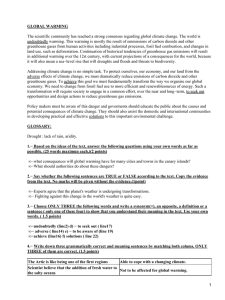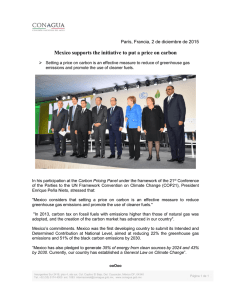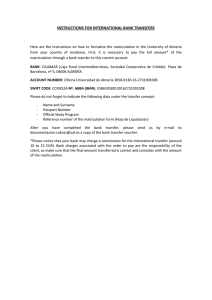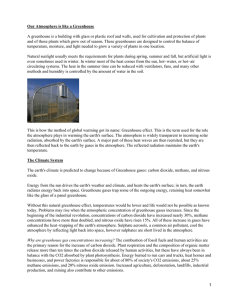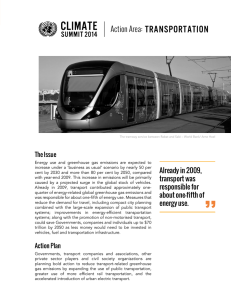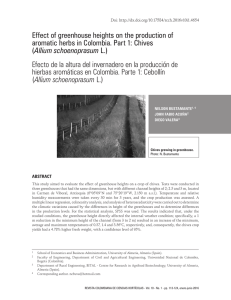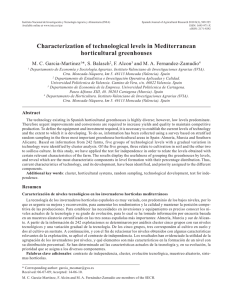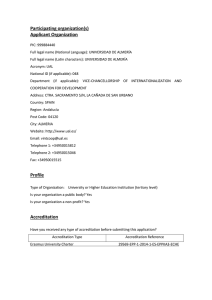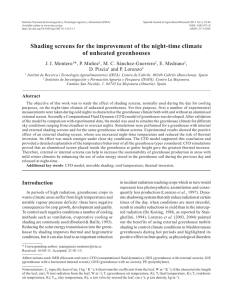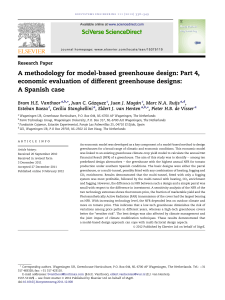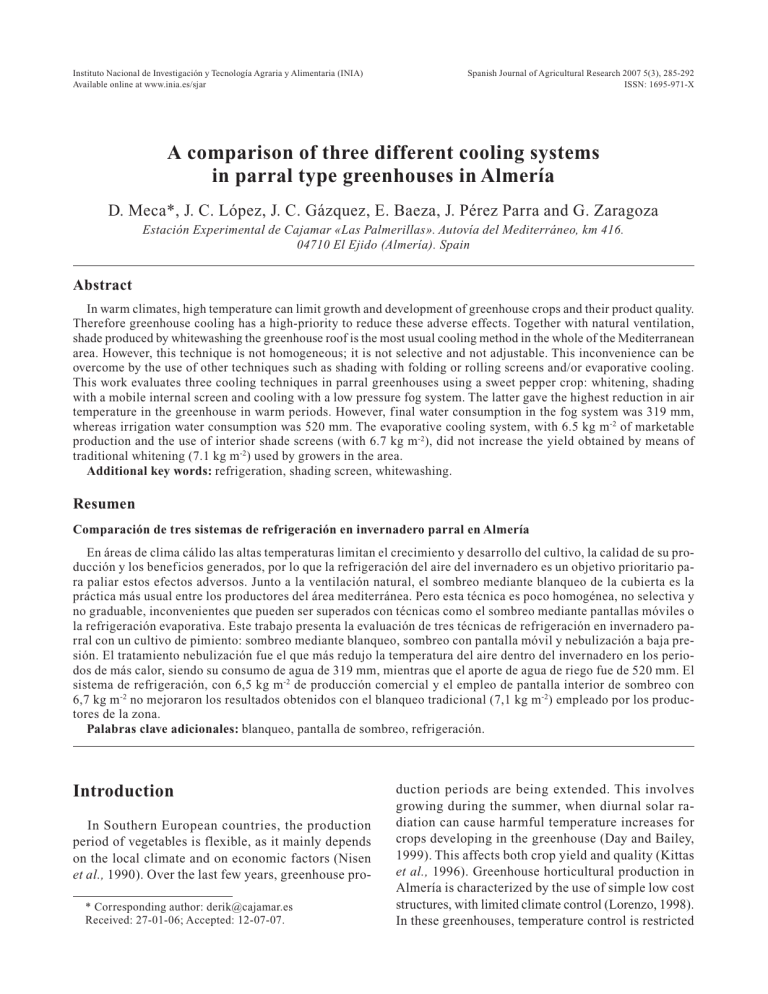
Instituto Nacional de Investigación y Tecnología Agraria y Alimentaria (INIA) Available online at www.inia.es/sjar Spanish Journal of Agricultural Research 2007 5(3), 285-292 ISSN: 1695-971-X A comparison of three different cooling systems in parral type greenhouses in Almería D. Meca*, J. C. López, J. C. Gázquez, E. Baeza, J. Pérez Parra and G. Zaragoza Estación Experimental de Cajamar «Las Palmerillas». Autovía del Mediterráneo, km 416. 04710 El Ejido (Almería). Spain Abstract In warm climates, high temperature can limit growth and development of greenhouse crops and their product quality. Therefore greenhouse cooling has a high-priority to reduce these adverse effects. Together with natural ventilation, shade produced by whitewashing the greenhouse roof is the most usual cooling method in the whole of the Mediterranean area. However, this technique is not homogeneous; it is not selective and not adjustable. This inconvenience can be overcome by the use of other techniques such as shading with folding or rolling screens and/or evaporative cooling. This work evaluates three cooling techniques in parral greenhouses using a sweet pepper crop: whitening, shading with a mobile internal screen and cooling with a low pressure fog system. The latter gave the highest reduction in air temperature in the greenhouse in warm periods. However, final water consumption in the fog system was 319 mm, whereas irrigation water consumption was 520 mm. The evaporative cooling system, with 6.5 kg m-2 of marketable production and the use of interior shade screens (with 6.7 kg m-2), did not increase the yield obtained by means of traditional whitening (7.1 kg m-2) used by growers in the area. Additional key words: refrigeration, shading screen, whitewashing. Resumen Comparación de tres sistemas de refrigeración en invernadero parral en Almería En áreas de clima cálido las altas temperaturas limitan el crecimiento y desarrollo del cultivo, la calidad de su producción y los beneficios generados, por lo que la refrigeración del aire del invernadero es un objetivo prioritario para paliar estos efectos adversos. Junto a la ventilación natural, el sombreo mediante blanqueo de la cubierta es la práctica más usual entre los productores del área mediterránea. Pero esta técnica es poco homogénea, no selectiva y no graduable, inconvenientes que pueden ser superados con técnicas como el sombreo mediante pantallas móviles o la refrigeración evaporativa. Este trabajo presenta la evaluación de tres técnicas de refrigeración en invernadero parral con un cultivo de pimiento: sombreo mediante blanqueo, sombreo con pantalla móvil y nebulización a baja presión. El tratamiento nebulización fue el que más redujo la temperatura del aire dentro del invernadero en los periodos de más calor, siendo su consumo de agua de 319 mm, mientras que el aporte de agua de riego fue de 520 mm. El sistema de refrigeración, con 6,5 kg m -2 de producción comercial y el empleo de pantalla interior de sombreo con 6,7 kg m -2 no mejoraron los resultados obtenidos con el blanqueo tradicional (7,1 kg m -2) empleado por los productores de la zona. Palabras clave adicionales: blanqueo, pantalla de sombreo, refrigeración. Introduction In Southern European countries, the production period of vegetables is flexible, as it mainly depends on the local climate and on economic factors (Nisen et al., 1990). Over the last few years, greenhouse pro* Corresponding author: [email protected] Received: 27-01-06; Accepted: 12-07-07. duction periods are being extended. This involves growing during the summer, when diurnal solar radiation can cause harmful temperature increases for crops developing in the greenhouse (Day and Bailey, 1999). This affects both crop yield and quality (Kittas et al., 1996). Greenhouse horticultural production in Almería is characterized by the use of simple low cost structures, with limited climate control (Lorenzo, 1998). In these greenhouses, temperature control is restricted 286 D. Meca et al. / Span J Agric Res (2007) 5(3), 285-292 to management of natural ventilation to limit extreme values of humidity and temperature (Abreu and Meneses, 1994; Abreu et al., 1994). Natural ventilation is the most practical, economic and therefore the most used method to lower greenhouse temperatures during the day. Most of the greenhouses have manual ventilation systems, 90% of them have side vents which open and close by simple sliding of plastic film and 31% of the greenhouses do not have roof ventilation or have a low eff iciency (36%) sliding type (Fernández and Pérez Parra, 2005). Moreover, the ventilation open area is insufficient (i.e. far below recommended literature values of 25-30% of open area in relation to the area covered by the greenhouse (Okhushima et al., 2001). The general use of low porosity insect screens on greenhouse vents to limit the entrance of small insects such as Bemisia tabaci and Frankliniella occidentalis, (mainly) which transmit viral diseases, decrease even more the ventilation area. Thus, natural ventilation is not sufficient to extract excess energy from the greenhouse during sunny, summer days (Baille, 1999). Summer conditions for crops in these greenhouses are far from optimal, especially in relation to temperature and vapour pressure deficit. For this reason, growers also use shade by whitewashing the greenhouse roof to reduce the amount of radiation entering the greenhouse. The combination of both «natural ventilation and whitewashing the roof» is the most common method used to cool greenhouses in summer. However, whitening the roof is inconvenient. It can not be removed on cloudy days; it is not applied evenly, which results in different amounts of light reaching plants in different parts of the greenhouse; labour is required to apply it and to remove it; it is also not selective, as approximately the same percentage of photosynthetically active radiation (PAR) and near infrared radiation (NIR), responsible mainly of heat, is transmitted (Montero et al., 1998). For this reason, other cooling systems, such as forced ventilation, reduce that incident radiation by means of folding shade screens or use of evaporative cooling systems (pad and fan, fog systems) can, potentially, be more efficient alternatives to control high greenhouse temperatures. The main objectives of this work were to evaluate the effect of a low pressure evaporative fogging system, a folding screen shade system and the common roof whitening on the greenhouse climate and their influence on the production of a bell pepper crop, in a parral type Almería greenhouse. Material and Methods The experiment was performed at the Cajamar «Las Palmerillas» Experimental Station at El Ejido (Almería) at an altitude of 155 m, 36º 47’ 40” N and 2º 43’ 10” W, during autumn 2002-2003. Three analogue multispan parral greenhouses were used for the experiment (Pérez Parra et al., 2004). Each greenhouse had 5 spans with their ridge oriented northsouth, ridge height was 4.2 m, gutter height 3.3 m and a roof area of 882 m2; automated roof and side vents were protected with 20 × 10 thread cm-2 insect screen. Greenhouse cladding was colourless three-layer plastic film with a thickness of 200 µm. The crop was a red bell pepper (Capsicum annuum L.) cv. Vergasa (Syngenta Seeds). Seed was sown in a nursery on 11 June 2002 and seedlings were transplanted to the greenhouse on 15 July 2002. The growing cycle f inished on 6 March 2003. The total duration of the growing cycle was 232 days. In Almería California type sweet peppers are transplanted to greenhouses between early June and early August, and the crop cycle ends between late January and late February. Crop rows were 1.9 m apart with 0.25 m between plants. Final plant density was 2.1 plants m-2. Plants were pruned to leave three main stems per plant, giving a density of 6.3 stems m-2 («Dutch» type trelling). The crop was grown in B-12 (0-5 mm granule size) perlite in 40-L bags laid over a polystyrene channel to collect drainage. The following cooling treatments were compared: — T 1: a low pressure fogging system comprising a pump unit and a water distribution net. The pump unit included filters and a pump (giving a pressure of 4 atm). Water was from a rainfall reservoir. There were 5 fogging lines in each greenhouse, N-S oriented, each line was 4 m from the other. Lines were polyethylene pipe with fogging nozzles with an average flow of 7 L h-1 separated 1.5 m (0.16 nozzles m-2). A vapour pressure deficit (VPD) set point of 1 kPa was set. — T2: aluminium internal folding shade screen (ULS 15 F, Ludvig Svensson), 50% shade and 20% energy saving, made of aluminium sheets with open spaces held together with strong polyester filament yarn. The special aluminium gives superior reflection and transmission efficiency, while the open spaces allowed sufficient airflow to give a considerable reduction in air temperature. The screen was 2.8 m above the green- Comparison of different cooling systems in parral type greenhouses house floor. The temperature set for screen activation was 27ºC. — T3: whitening the greenhouse roof by applying calcium carbonate dissolved in water (Blanco de España) at 25 kg for every 100 L of water. The lime was applied using the normal local technique. It was applied on 14 July 2002 and washed off on 7 October 2002. Dry and wet bulb temperatures were measured inside and outside the greenhouse with ventilated psychrometers with Pt-100 sensors (Fig. 1). The VPD was calculated from these measurements. Each greenhouse had two ventilated psychrometers, one at 1.5 m and the other 3.5 m above the ground. Thus in the folding screen treatment greenhouse there was one psychrometer above the screen and one below (Fig. 1). Climate control and management was done using 30 s measurements averaged every 5 min. The transmissivity of the covering material to PAR radiation was determined as the ratio between incoming radiation inside the greenhouse and the outdoor radiation, from an average of 5 measurements in an East-West direction in each greenhouse, using a linear sensor (LICOR Inc, Lincoln, Nebraska, USA). These measurements were taken on sunny days at noon [12:00 Greenwich Mean Time (GMT)]. To determine treatment effect on crop production, a one-factor experimental design with three treatments (T1, T2 and T3), five repetitions per treatment, and 16 plants per repetition was used. Both marketable and non-marketable yield was determined at each harvest. Fruits were also classified into different categories, using precision scales (mod. Metler Toledo deviation of ± 1 g), according to the sweet pepper quality standard (OJ, 2000). Fogging system T1 Results Climate The average temperatures during the day (Table 1 and Fig. 2), measured by the psychrometer at 1.5 m above the ground, were 22.4 ± 4.4ºC for T1, 23.2 ± 5.6ºC for T2 and 22.6 ± 4.9ºC for T3; all values were higher than the average temperature outdoors (T out) of 20.9 ± 5.4ºC. The maximum temperatures, at this height, were reached during summer. The hottest day was 5 August, with the following maximum temperatures: Tout: 35.5 ± 4.4ºC; T1: 36 ± 4.1ºC; T2: 43.3 ± 6.2ºC and T3: 36.8 ± 4.5ºC. During the period when the fogging system was used to maintain the VPD set point (until 90 days after transplanting or DAT), the average relative humidity during the day for T1 (74 ± 7.4%) was higher than in T2 (56.3 ± 10.3%) and T3 (61.9 ± 9.7%) (Table 1 and Fig. 3). Figure 4 shows change in temperature and VPD on a typical summer day. The temperature reached at the middle of the day for T 1 was 1.5ºC and 3.3ºC lower than in T 3 and T 2, respectively. Something similar occurred with VPD values, T1 kept values below 2 kPa. In the other two treatments values above 3 kPa and even up to 4 kPa, in T2, were reached. These values occurred at the start of the crop cycle, when the plants had a very low leaf area index and crop transpiration was very limited. Table 2 shows the average temperature jumps in relation to the outdoor temperature at heights of 1.5 and 3.5 m above the ground, and for two outdoor wind conditions (Ve = 0-2 and Ve = 5-8 m s-1, where Ve is the outside wind velocity) for days with different wind velocities at noon (GMT) for the period with whitewash (0-83 DAT). At both 1.5 m and 3.5 m the highest tem- Folding shade screen T2 Aspiropsychrometer 3.5 m 1.5 m 1.5 m Whitening T3 Aspiropsychrometer 3.5 m 2.8 m 2.8 m 287 Aspiropsychrometer 3.5 m 2.8 m 1.5 m 1.5 m Figure 1. Scheme showing the three different greenhouse treatments evaluated: (T1) low pressure fogging system, (T2) folding internal shade screens, and (T3) whitewashed roof. 288 D. Meca et al. / Span J Agric Res (2007) 5(3), 285-292 Table 1. Diurnal average temperature and relative humidity and standard deviation (±) for the daylight period inside greenhouses for three cooling treatments and outdoor over Period 1 (up to whitewashing, 0-83 DAT), over Period 2 (from whitewashing, 84-232 DAT) and over the full crop cycle (0-232 DAT) Period 1 Period 2 Cycle 26.4 ± 2.2 26.5 ± 2.2 29.1 ± 2.7 27.6 ± 2.3 17.1 ± 3.2 19.6 ± 3.1 19.3 ± 3.0 19.3 ± 3.0 20.9 ± 5.4 22.4 ± 4.4 23.2 ± 5.6 22.6 ± 4.9 56.0 ± 8.9 74.0 ± 7.4 56.3 ± 10.3 61.9 ± 9.7 61.5 ± 11.2 77.1 ± 8.3 77.6 ± 10.3 76.5 ± 10.7 59.3 ± 10.6 75.9 ± 8.1 69.2 ± 14.6 70.6 ± 12.5 Diurnal average temperatures (ºC) Outdoor Fogging system (T1) Shade screen (T2) Roof whitewashed (T3) Diurnal average relative humidity (%) Outdoor Fogging system (T1) Shade screen (T2) Roof whitewashed (T3) about 52%, in T2 with 95% extended screen it was 21% and in T3 it was 28%. perature differences were always in the folding screen treatment, and ranged between 2.7ºC and 11.2ºC, respectively. Only the fogging treatment (T1) decreased the greenhouse air temperature in relation to the temperature outdoors by up to –1.2ºC at 1.5 m. The whitening treatment results were intermediate between the other two treatments. The temperature difference between the inside and the outside (T i-T out) was between 2ºC and 4.1ºC. In relation to PAR during the time the whitening was on the roof (0-83 DAT), the transmissivity of T1 was Production The first peppers were harvested at 71 DAT and the last at 232 DAT. There were a total of 21 harvests. The higher total yield, for the whole growing cycle, was from T1 at 8.7 kg m-2, followed by T3, 8 kg m-2, and T2 at 7.4 kg m-2. The differences were statistically signi- 40 35 T (ºC) 30 25 20 15 10 5 0 10 20 30 40 50 60 70 Tout 80 90 100 110 DAT T1 120 130 T2 140 150 160 170 180 190 200 T3 Figure 2. Change in the average diurnal temperature (ºC) for the three treatments: fogging system (T 1), shade screen (T2), whitewashed greenhouse roof (T3) and outdoors (Tout). Comparison of different cooling systems in parral type greenhouses 289 100 80 RH (%) 60 40 20 0 0 10 20 30 40 50 60 70 80 90 100 110 120 130 140 150 160 170 180 190 200 DAT RHout RH1 RH2 RH3 Figure 3. Change in the diurnal relative humidity (%) for the fogging system (RH1), shade screen (RH2), whitewashed greenhouse roof (RH3), and outdoors (RHout). ficant (P < 0.05). However, there was no difference in final marketable pepper yield among the three treatments (mean 6.8 kg m -2, Table 3 and Fig. 5). Differences in fruit quality favoured T3 (60.6% I Category) and T2 (61.1% I Category) in relation to T1 (44.1% I Category). T 3 was signif icantly different to T 1. The proportion of non-marketable was statistically higher (P < 0.05) under fogging (2.2 kg m -2) compared to whitening (0.9 kg m-2) or the shade screen (0.7 kg m-2). Plants from T1 had higher early total and marketable production than in the other two treatments, 3.3 and 2.9 kg m-2 (at 120 DAT) of total and marketable peppers respectively, compared with 2.8 and 2.7 kg m-2 for T3 Climate Treatment T 1 was best at decreasing glasshouse temperature in relation to Te (∆T of 1.5ºC against 2.3ºC in T 2 and 1.7ºC in T 3). These results are lower than those of Perdigones et al. (2004), who obtained temperature differences (∆T) of –0.8ºC using a low pressure 45 100 5 40 80 4 35 60 % T (ºC) Discussion 30 40 25 20 15 0 4 T1 8 T2 12 Hour T3 16 Tout 20 24 % shading VPD(kPa ) A and 2.1 kg m-2 for both total and marketable peppers in T2 (Fig. 5). B 3 2 20 1 0 0 0 4 8 T1 12 Hour T2 16 T3 20 24 Tout Figure 4. Hourly change in daytime of (A) temperature (ºC) and (B) Vapour Pressure Deficit (VPD) for the fogging system (T1), shade screen (T2), whitewashed greenhouse roof (T3) and outdoors on a typical summer day (30th July). Average wind velocity Ve1.8 m s–1. 290 D. Meca et al. / Span J Agric Res (2007) 5(3), 285-292 Table 2. The average air temperature difference between the inside and the outside (Ti-Tout) and corresponding standard deviation at noon GMT of two ventilated psychrometers at 1.5 m and 3.5 m above ground level respectively for the three treatments, and under two outdoor wind conditions (wind velocities of ≈ 0-2 m s–1 and 5-8 m s–1 respectively) for Period 1 (0-83 DAT) Temperature difference (Ti-Tout) Ve ≈ 0-2 m s–1 Fogging system (T1) Shade screen (T2) Roof whitewashed (T3)1 1 Ve ≈ 5-8 m s–1 1.5 m 3.5 m 1.5 m 3.5 m –0.2 ± 1.4 2.7 ± 0.7 2.0 ± 0.5 3.2 ± 0.5 11.2 ± 1.8 4.1 ± 1.0 –1.2 ± 0.9 6.0 ± 1.5 2.2 ± 0.5 1.0 ± 0.6 8.5 ± 0.9 3.2 ± 0.5 In T3 roof was whitewashed for the entire period. fogging system and a ∆T of 1.7ºC using a mobile aluminium internal shade screen at 65% shade. Francescangeli et al. (1994), in tunnel type greenhouses, in which incident radiation was reduced by whitening and with a shade screen, reported differences of 2-3ºC compared to a control greenhouse. At high radiation levels, the temperature of the aerial part of the plant, directly exposed to the sun, can be up to 10ºC higher than the surrounding air temperature (Van Holsteijn, 1998). This can induce excess temperature stress damage, irregular fruit development and yield loss. Sáez (2005) compared leaf and air temperatures (Tleaf - Tair) of a pepper crop using a high pressure fog system, forced ventilation and whitening, and obtained a positive difference in the fog system greenhouse. Leaf temperatures were higher than air temperatures, which could be interpreted as a stress symptom. Montero et al. (1981), working with a tomato crop, concluded that under sunny conditions leaf temperature was lower than greenhouse air temperature at humidity levels below 80%, but it was significantly higher at levels approaching saturation. The most probable explanation for this was that at high humidity, transpiration could have been limited and leaves were unable to be cooled as much as under a low humidity. Recorded temperatures in T2 were higher than in the other two treatments, due to limited air movement, and thus air renewal in the greenhouse, when the screen was extended. This was opposite to the desired effect, especially on days with low winds. Gómez (2001) determined that the aluminium screen shade systems when placed in a greenhouse were no more effective in decreasing daytime temperatures than traditional whitening. Fernández et al. (2003) also argued that the use of aluminium shade screens as to prevent heat stress in multispan parral type greenhouses to reduce air temperature was not as effective as whitening. The influence of the wind on the temperature differences (Ti-Te) differed among the three treatments: — Whitening: low wind velocities gave a temperature gradient of 2.1ºC between a height of 1.5 and 3.5 m. When Ve was higher (5-8 m s-1) the temperature gradient decreased to 1ºC. Sánchez (2002) also reported a vertical temperature gradient in a whitened greenhouse of 1ºC. — Screen: with low wind velocities Ve < 2 m s-1, the vertical temperature gradient was 8.5ºC, due to decreased air renewal caused by the internal screen. When the V e ≈ 5-8 m s -1 the gradient was reduced to 2.5ºC. Sánchez (2002) found that internal shade screens caused a high vertical thermal gradient in the greenhouse with temperatures up to 4.6ºC higher above the screen than below it. — Fogging system: with low wind (V e < 2 m s -1), the evaporative cooling system decrease the temperature Table 3. Total, marketable and separated production categories for the whole growing cycle (0-232 DAT). Values followed by a different letter are significantly different (p < 0.05) Treatment Fogging system (T1) Shade screen (T2) Roof whitewashed (T3) Total production (kg m–2) Marketable production (kg m–2) Category I (kg m–2) Category II (kg m–2) Non-marketable (kg m–2) 8.7 a 7.4 c 8.0 b 6.5 a 6.7 a 7.1 a 3.8 b 4.5 ab 4.8 a 2.7 a 2.2 b 2.3 b 2.2 a 0.7 b 0.9 b Comparison of different cooling systems in parral type greenhouses 291 8 7 6 kg m-2 5 4 3 2 1 0 0 20 40 60 80 100 120 140 160 180 200 220 240 DAT July August September October T1 November T2 December January February March T3 Figure 5. Accumulated marketable pepper production (kg m–2) during the growing season (232 days) for the fogging system (T1), shade screens (T2) and whitewashed greenhouse roof (T3). at 1.5 m to values close to the exterior temperature. When wind velocity increased (V e ≈ 5-8 m s -1), the system was more efficient, and gave a –1.2ºC at 1.5 m and –1ºC at 3.5 m compared with the exterior temperature because of higher air renewal. The fogging system was not able to maintain the VPD set point of 1 kPa in T1, during high demand periods and gave a f inal water consumption of the fogging system of 319 mm, whereas water consumed for irrigation was 520 mm. It was also observed that the low pressure fogging system, at times, wet the crop at certain moments, due to larger water drops. Montero et al. (2003) suggested that the VPD set point in a Mediterranean climate should not be below 1.5 kPa to avoid wetting plants. Fernández et al. (1998) reported a similar transmissivity value (c. 31%) in a parral greenhouse with similar whitening. produced the most marketable peppers compared with T 1 and T 2. Aroca (2003) also reported higher production of marketable pepper with whitening compared with a high pressure fogging system. Abreu and Meneses (2000) compared the effect of whitening on the yield of tomatoes in a greenhouse during the spring crop cycle in Portugal and found the control treatment (no whitening) gave the highest total production. Treatment T1 was the most precocious (2.9 kg m-2 at 120 DAT), while T2 treatment only produced 2.1 kg m-2. In many horticultural crops, flower retention by the plant, and fruit development are extremely sensitive to environmental stress. Aloni et al. (1996) showed that flower abscission in a pepper crop was increased under low light and high temperature conditions. This had a negative effect on production. Conclusions Plant production The T1 treatment gave higher total and non-marketable pepper production than the other two treatments (Table 3). This was mainly due to the large number of deformed and parthenocarpic peppers. Treatment T3 The fogging system was the most effective in controlling high greenhouse temperatures. The fogging system also efficiently maintained relative humidity and VPD values. Interior folding screens were not efficient in controlling high temperatures (maximum ∆T 7.8ºC) and 292 D. Meca et al. / Span J Agric Res (2007) 5(3), 285-292 caused undesirable thermal stratification which greatly affected greenhouse roof natural ventilation. Plants grown under the fogging system were more precocious and had a higher final total yield but quality was negatively affected. This gave lower marketable pepper production than in the whitening treatment. Shading the greenhouse by folding screens gave the worst production. References ABREU P.E., MENESES J.F., 1994. Climatic characterisation of two plastic covered greenhouses under different natural ventilation methods, with a cold season tomato crop. Acta Hort 366, 183-194. ABREU P.E., MENESES J.F., 2000. Influence of soil covering, plastic ageing and roof whitening on climate and tomato crop response in an unheated plastic Mediterranean greenhouse. Acta Hort 534, 343-350. ABREU P.E., MENESES J.F., MONTEIRO A.A., 1994. Response of non heated plastic covered greenhouse tomatoes during the cold season under different natural ventilation methods. Acta Hort 366, 195-200. ALONI B., KARNI L., ZAIDMAN Z., SCHAFFER A., 1996. Changes of carbohydrates in pepper (Capsicum annuum L.) flowers in relation to their abscission under different shading regimes. Ann Bot 78, 163-168. AROCA R., 2003. Ensayo de un sistema de refrigeración evaporativa en un invernadero multitunel. Unpublished Proyecto Fin de Carrera. University of Almería. [In Spanish]. BAILLE A., 1999. Greenhouse structure and equipment for improving crop production in mild winter climates. Acta Hort 491, 31-47. DAY W., BAILEY B.J., 1999. Physical principles of microclimate modification. In: Greenhouses ecosystems (Stanhill G., Enoch H.Z., eds). Elsevier, Amsterdam. pp.71-97. FERNÁNDEZ C., PÉREZ PARRA J., 2005. Caracterización de los invernaderos de la provincia de Almería. Ed Cajamar, Almeria. pp. 17-20. [In Spanish]. FERNÁNDEZ E.J., FERNÁNDEZ J., KENIG A., CAMACHO F., 1998. Uniformidad del campo radiativo bajo sistemas de sombreo mediante pantallas aluminizadas en invernadero. Actas de Horticultura 21, 37-44. [In Spanish]. FERNÁNDEZ E.J., CAMACHO F., LAO M.T., KENIG A., JIMÉNEZ S., 2003. Effects of aluminized shading screens vs whitewash in a non heated greenhouse temperature. Acta Hort 614(1), 427-432. FRANCESCANGELI N., FERRATO J., ROSANIA A., LEVIT H., 1994. Efecto del blanqueado, sombreado y aspersión de agua sobre techo, en la temperatura y otros parámetros climáticos en invernaderos, durante el periodo estival. Acta Hort 357, 267-294. [In Spanish]. GÓMEZ V., 2001. Utilización de pantallas aluminizadas vs. encalado: efectos microclimáticos, productivos y cualitativos en pimiento. Unpublished Trabajo Monográfico. University of Almería. [In Spanish]. HAND D.W., 1998. Effects of atmospheric humidity on greenhouse crops. Acta Hort 229, 143-158. KITTAS C., BOULARD T., MERMIER M., PAPADAKIS G., 1996. Wind induced air exchange rates in a greenhouse tunnel with continuous side openings. J Agr Eng Res 65(1), 37-49. LORENZO P., 1998. Los determinantes microclimáticos de la horticultura intensiva en el sur mediterráneo. Tecnología de invernaderos II, 25-44. [In Spanish]. MONTERO J.I., SHORT T.H., CURRY R.B., BAUERLE W.L., 1981. Influence of evaporative cooling systems on greenhouse environment. American Society of Agricultural Engineers. St Joseph, Michigan. ASAE paper 81-4027. MONTERO J.I., ANTÓN A., MUÑOZ P., 1998. Refrigeración de invernaderos. In: Tecnología de invernaderos II. Curso de Especialización (Pérez-Parra and Cuadrado, eds). FIAPA, Almería. pp. 313-398. MONTERO J.I., ANTÓN A., MUÑOZ P., 2003. Nebulización: Efectos sobre el microclima, producción y eficiencia en el uso del agua. In: Mejora de la eficiencia en el uso del agua en cultivos protegidos. Curso de Especialización (Fernández M., Lorenzo P., Cuadrado I., eds). FIAPA, Almería. pp. 231-243. [In Spanish]. NISEN A., GRAFIADELLIS M., JIMÉNEZ R., LA MALFA G., MARTÍNEZ GARCÍA P.F., MONTEIRO A., VERLODT H., VILLELE O., ZABELTITZ C.H., 1990. Protected cultivation in the Mediterranean climate. FAO. Plant Production and Protection Paper No. 90. Rome, Italy. 313 pp. OJ, 2000. Commission Regulation (EC) No 2706/2000 of 11 December amending Regulation (EC) No 1455/1999 laying down the market standard for sweet peppers. Off icial Journal of the European Union L311. 12/12/2000. p. 35. OKHUSIMA L., SASE S., LEE I.B., BAILEY B., 2001. Thermal environment and stress of workers in naturally ventilated greenhouses under mild climates. Acta Hort 559(II), 763-768. PERDIGONES A., PASCUAL V., GARCÍA J.L., NOLASCO J., PALLARÉS D., 2004. Interactions of crop and cooling equipment on greenhouse microclimate. In: Greensys: sustainable greenhouses systems. Leuwen, Belgium, Sept 12-16. [In CD]. PÉREZ PARRA J., BAEZA E., MONTERO J.I., BAILEY B., 2004. Natural ventilation of parral greenhouses. Biosyst Eng 87(3), 355-366. SÁEZ M.I., 2005. Instalaciones de refrigeración en invernadero: efectos sobre el clima y producción de un cultivo de pimiento California. Unpublished Trabajo monográfico. University of Almería. [In Spanish]. SÁNCHEZ A., 2002. Estudio comparativo de dos sistemas de sombreo (pantalla aluminizada y encalado tradicional) en cultivo de pepino (Cucumis sativus L.) para ciclo de primavera. Unpublished Proyecto fin de carrera. University of Almería. [In Spanish]. VAN HOLSTEIJN G., 1988. Shading in the summer: in sunny weather cooler fruits and less evaporation. Groentenen-Fruit 43, 28-29.
